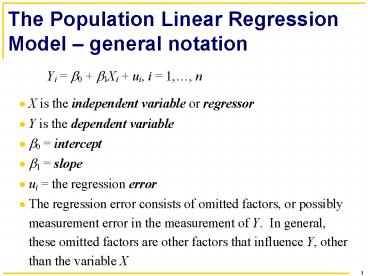The Population Linear Regression Model general notation - PowerPoint PPT Presentation
1 / 34
Title:
The Population Linear Regression Model general notation
Description:
Least squares assumption #2: (Xi,Yi), i = 1,...,n are i.i.d.. 20. Least squares assumption #3: Large outliers are rare Technical statement: E(X4) and E(Y4) ... – PowerPoint PPT presentation
Number of Views:30
Avg rating:3.0/5.0
Title: The Population Linear Regression Model general notation
1
The Population Linear Regression Model general
notation
2
Population Regression Line
3
The OLS estimator solves
4
(No Transcript)
5
Sample Regression Equation
chosen in sample not chosen in sample
Y
estimated error for X3 (residual)
Observed Value of Y for X3
Predicted Value of Y for X3
Estimated slope
estimated Intercept
X
X3
6
California Test Score/Class Size data
- Interpretations
7
Predicted values residuals
8
OLS regression STATA output
9
Measures of Fit(Section 4.3)
10
(No Transcript)
11
The Standard Error of the Regression (SER)
12
(No Transcript)
13
- Technical note why divide by (n-2) instead of
(n-1)? - When n is large, it makes negligible difference
whether n, n-1, or n-2 are used (although
conventional formula uses n-2 whre there is one
X)
14
Example of the R2 and the SER
15
The Least Squares Assumptions (SW Section 4.4)
16
The Least Squares Assumptions
17
Least squares assumption 1 E(uX x) 0.
18
Least squares assumption 1, ctd.
19
Least squares assumption 2 (Xi,Yi), i 1,,n
are i.i.d.
20
Least squares assumption 3 Large outliers are
rare Technical statement E(X4) lt ? and E(Y4) lt ?
21
OLS can be sensitive to an outlier
22
The Sampling Distribution of
23
The mean and variance of the sampling
distribution of
24
(No Transcript)
25
(No Transcript)
26
Now we can calculate E( ) and var( )
27
Next calculate var( )
28
(No Transcript)
29
What is the sampling distribution of ?
30
Large-n approximation to the distribution of
31
The larger the variance of X, the smaller the
variance of
32
The larger the variance of X, the smaller the
variance of
33
Summary of the sampling distribution of
34
(No Transcript)































